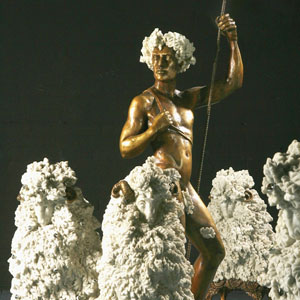
Any sustained contemplation of the baroque, Walter Benjamin once wrote, causes one to slip into an almost hysterical imitation of its form. Through visual and sensorial excesses, spatial dynamism and impetus to movement within decentred or shifting compositions, the baroque aesthetic has never lent itself to an affectively restrained or stably ordered worldview. Likewise, the sensibility of camp as it veers towards artifice and exaggeration constitutes a rejection of minimalism and restraint. Despite vastly different inceptions (seventeenth-century Europe and the emergence of camp as ironic commentary in the late sixties), the survey show, Chaos and Revelry, explores the affinities between these styles. Such an exhibition joins the ranks of work by an increasing number of critics, filmmakers and artistic practitioners who view the baroque as a trans-historic aesthetic. Like camp, the neo-baroque of Bartlem's artists address the body as a site of performance and tangible sensation.
The strongest works in the show are those that preserve a fascinating continuity with the historic baroque even as they use different technological or cultural terms. The baroque tendency towards an almost infinite sense of spatial expansion matched to an equally weighted attention towards the minutiae of detailing is evident in Kate Cotching's delicately suspended, luridly hot-pink paper installation, An establishment for the diffusion of knowledge (2005). Cotching effectively reprises the simultaneously expansive and contractive spatiality of baroque form in her laborious cutting and layering of hand-coloured paper. As with the historic art of anamorphosis, what first appears to be a chaotic or shapeless image is, upon closer inspection, an intricately interwoven and carefully constructed landscape of paper buildings and cranes. eX de Medici's watercolor Desire overcoming Duality (2006) pays homage to the vanitas tradition of the sixteenth and seventeenth centuries and its preoccupation with the fleetingness of and decay brought about by the flow of time. Drawing on a self-consciously baroque iconography of skulls and jewels, de Medici's vanitas is an illusionistic medley of different colours and textures that includes references to her own practice as a tattooist. Its meaning is intriguingly elusive and indeterminate for the visitor: are we to laugh at the seemingly innocuous presentation of these skulls in their bejeweled fluffiness or do their lavish decorations conceal a darker, perhaps mocking intent?
The stand-out works of Chaos and Revelry are unquestionably the sculptures of William Eicholtz and the photographs of Deborah Paauwe and Maree Azzopardi. Eicholtz's eclectic sculptures twist the symbolism of sheep and shepherds into the unabashedly flamboyant, his Prince in the Cabriole Pasture (2007) with its bronzed/gilt surfaces, faux marble and appearance of furniture seating is less Bernini than Franco Cozzo by way of Versailles. By contrast, the inclusion of a number of Paauwe's large-scale photographs from her Crying Room (2006) and Magic Window (2004-2005) series astutely invokes the sensuous materiality of baroque surfaces and its highly tactile renderings of flesh, drapery, folds and supply moving fabrics. In Paauwe that conjunction of flesh and fabric is slightly unnerving, exposing the vulnerability of the body (blemishes, scratches, girlhood) amidst romanticised imagery of flowing tulle, pastel colors and pearls. Azzopardi's new photographs Flowergirl #1, Pink, Family, Angela Blood, Wings (all 2007) deservedly occupy an entire wall of the gallery and are nothing short of stunning. This deeply personal series fuses the artist's remembrances of her Catholic childhood in Malta with staged photographs of her niece. In their blend of luscious golden light, color, gilt surfaces and religious imagery of angels, saints and martyrs, the crumpled appearance of these gorgeous works is like the neo-baroque itself, poised between the past and the present in the continued reinvention and renewal of baroque form.
While sometimes irreverent and often humorous Chaos and Revelry is an intellectually considered exhibition. The decorative, ornamental and sensuously textured surfaces of its works are charged repositories of meaning that move between pleasure and pain, between the aesthetics of camp and the neo-baroque.












